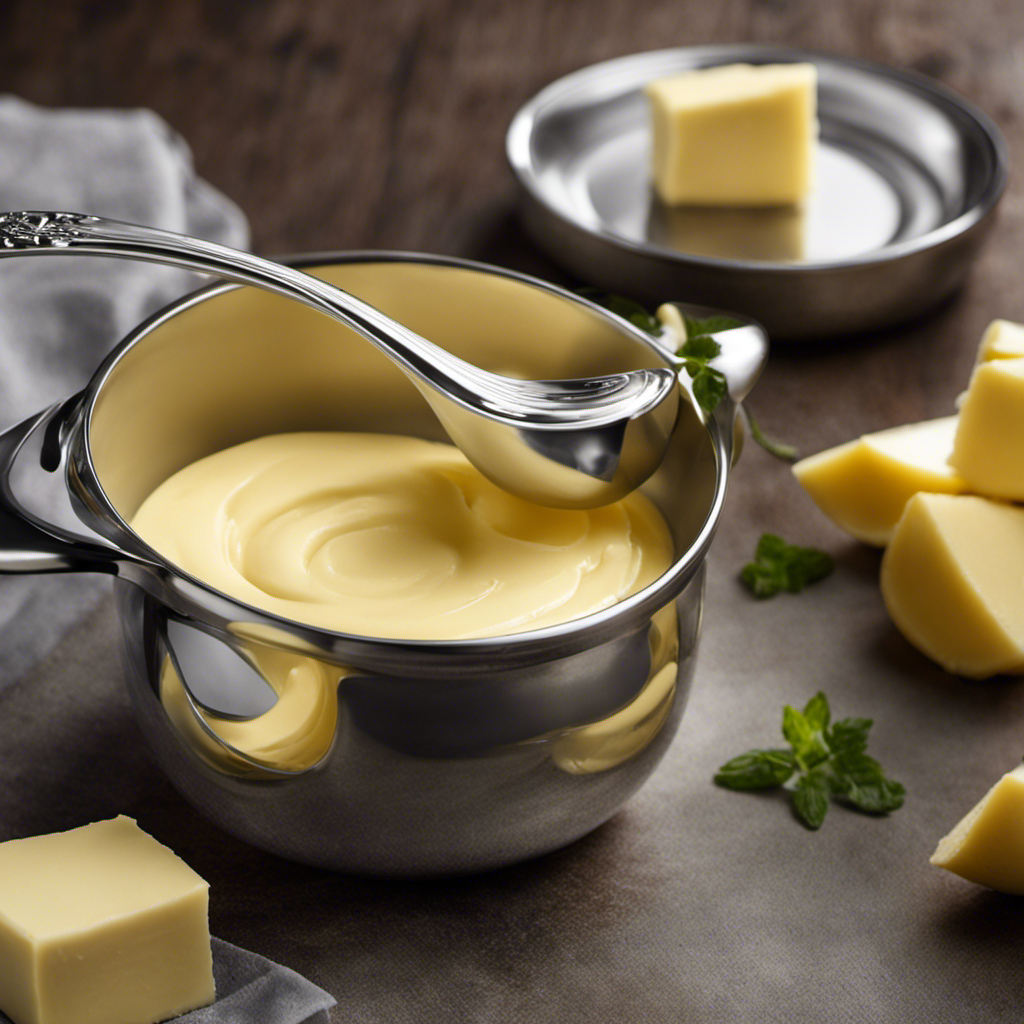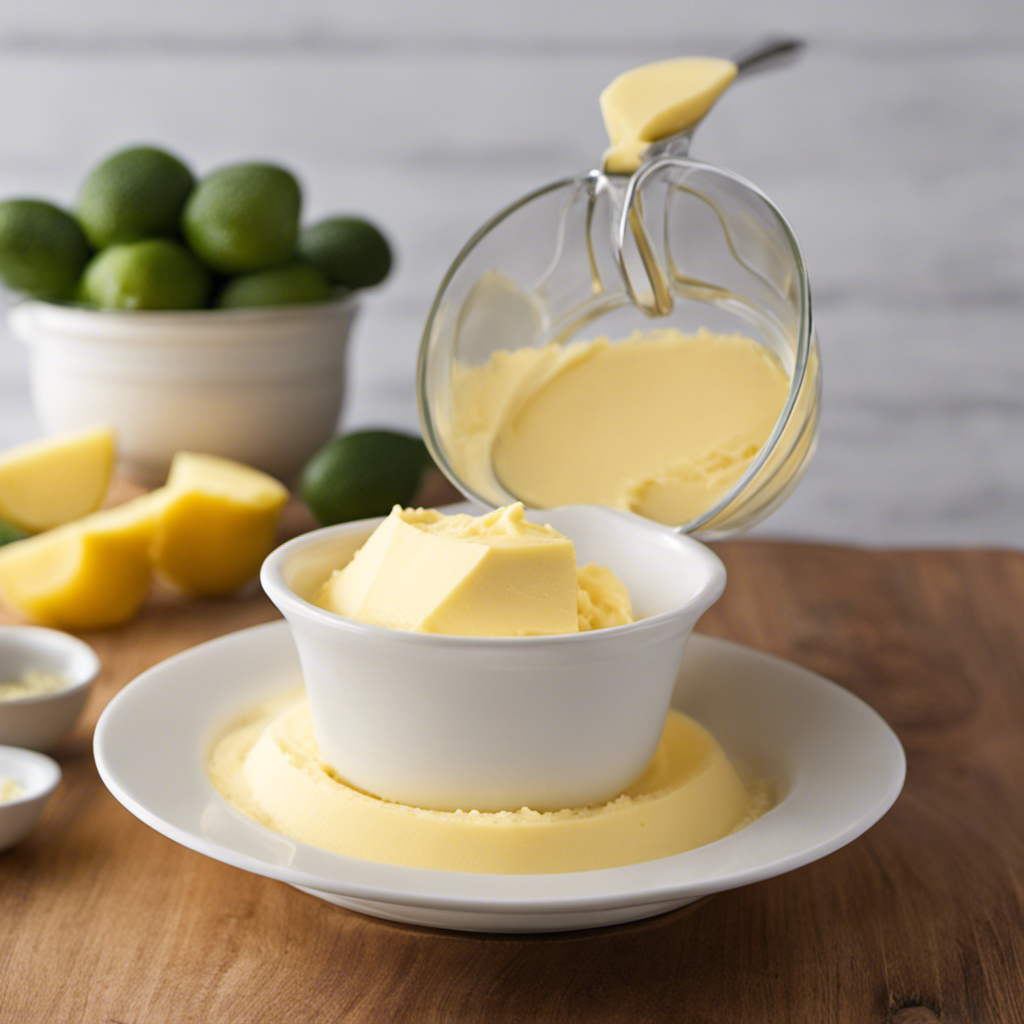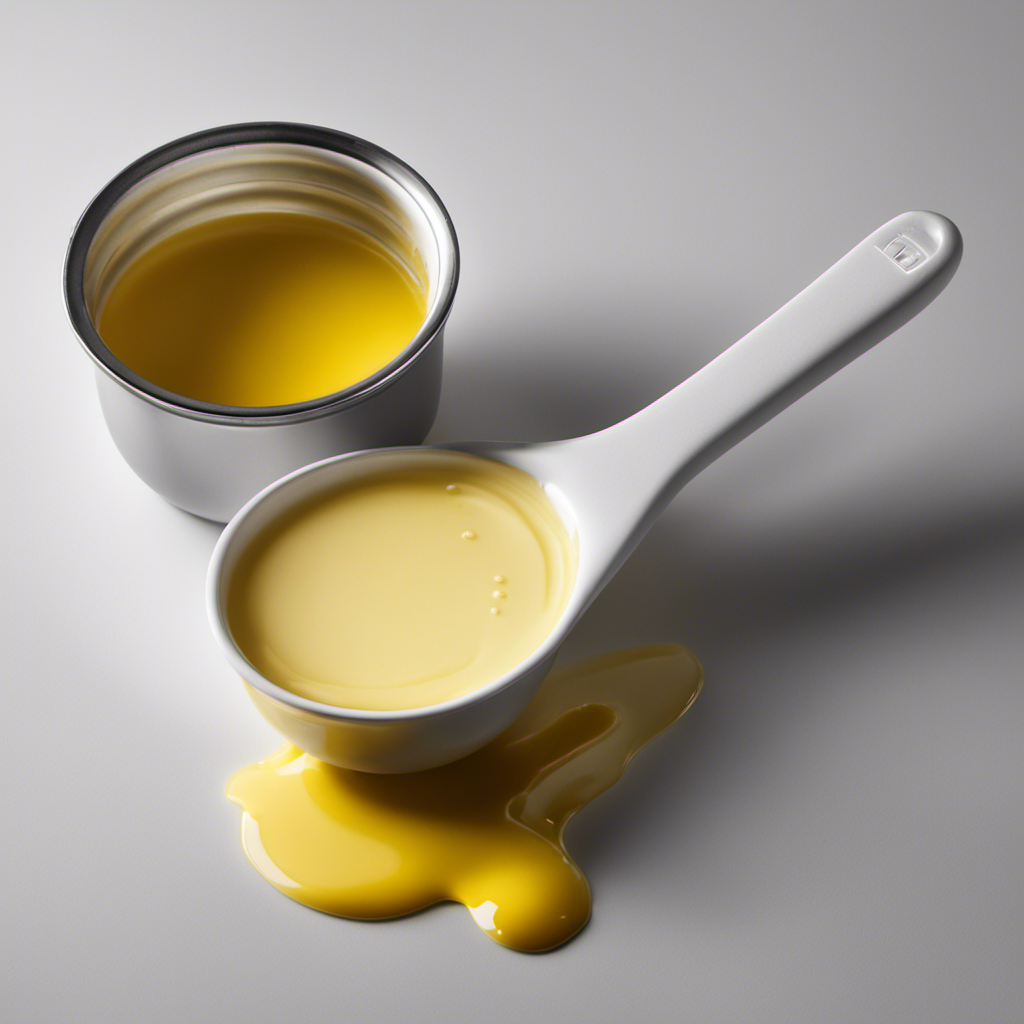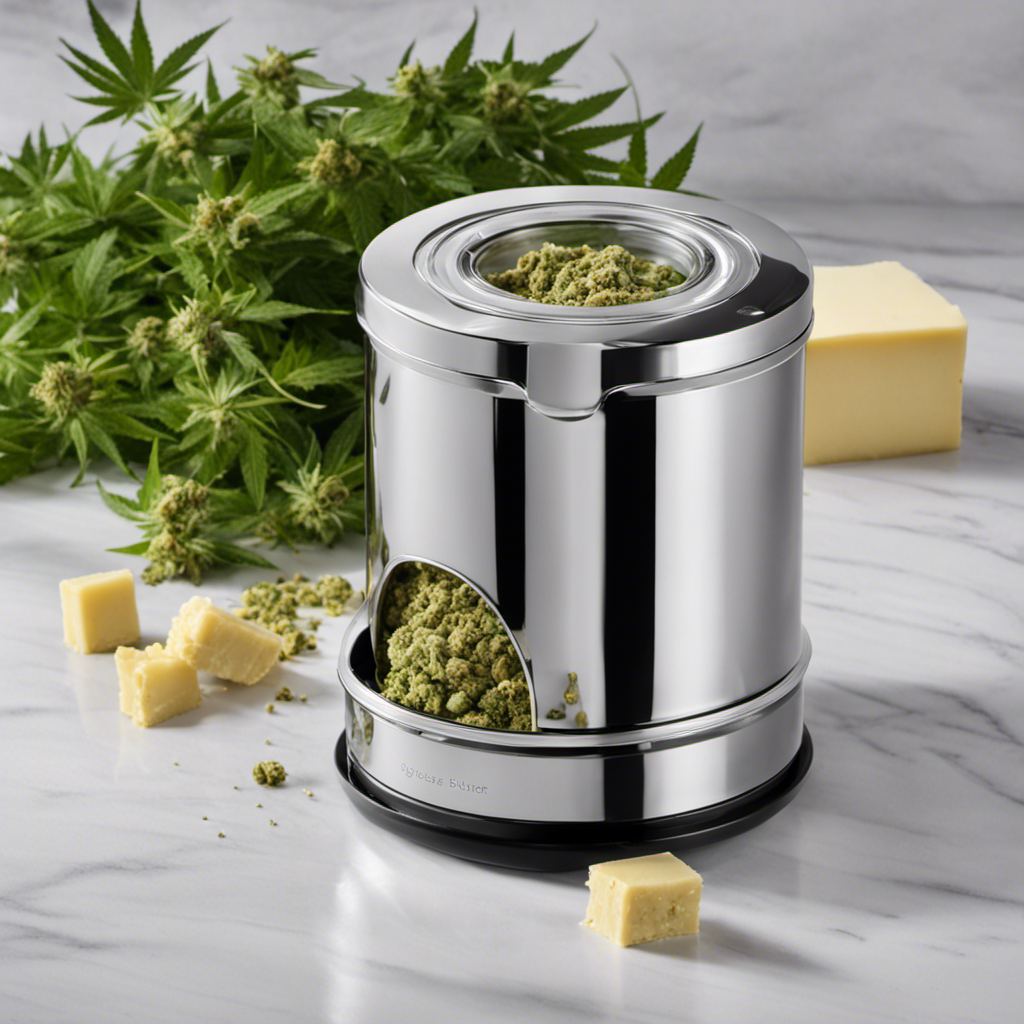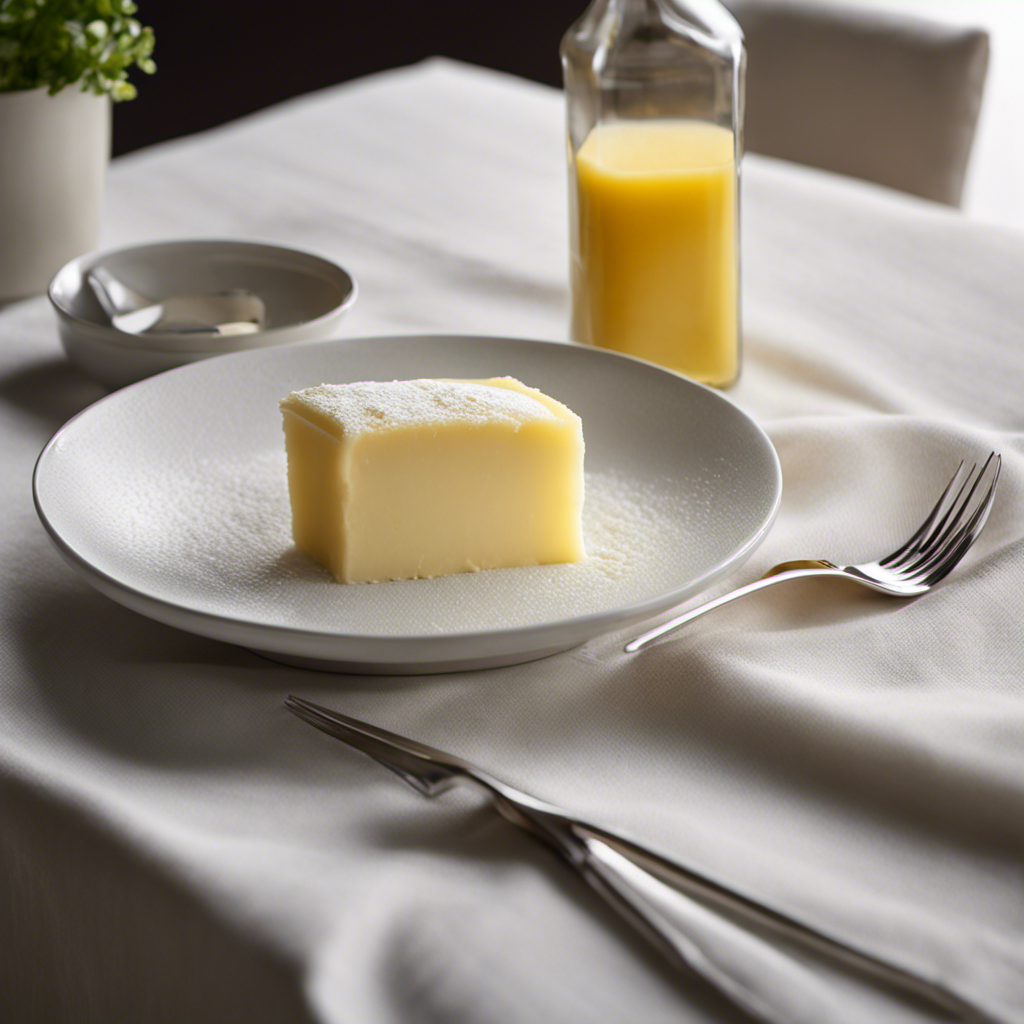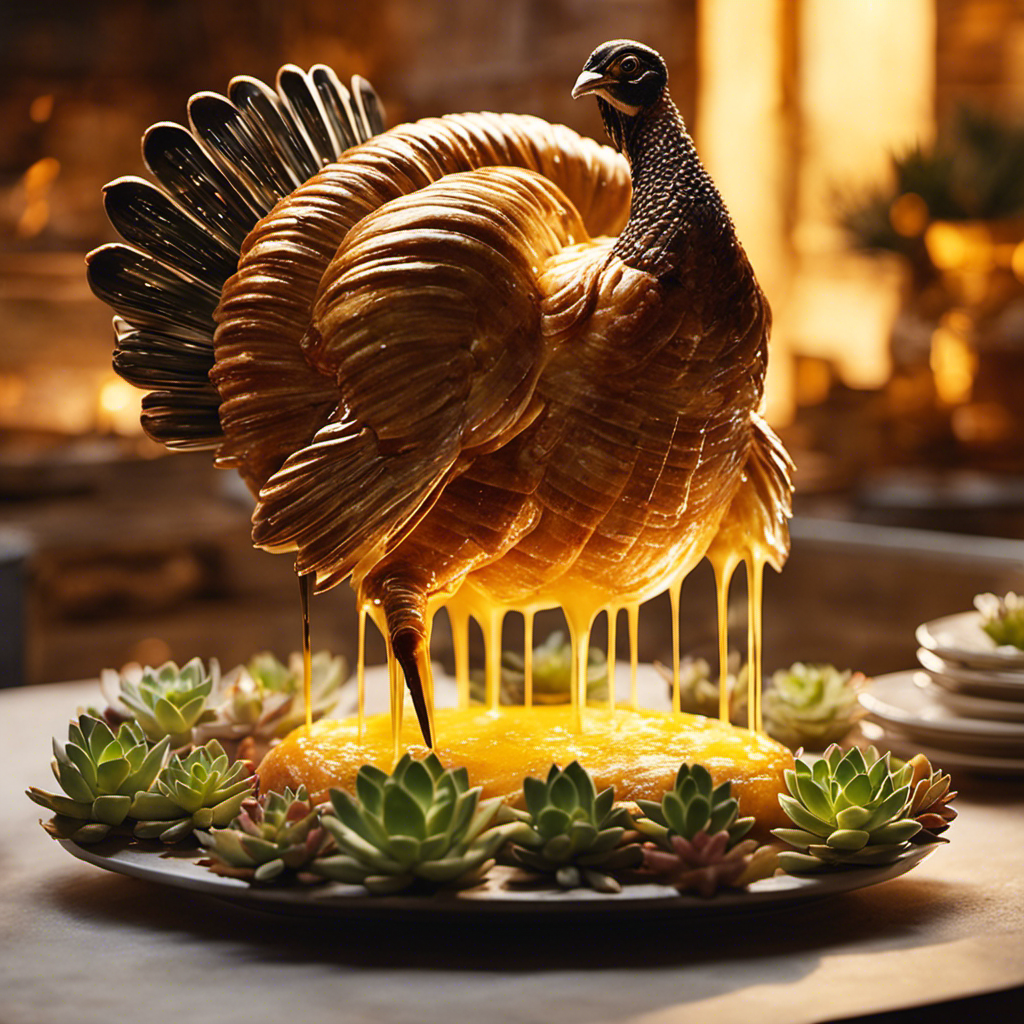I’ve always been curious, what does 3/4 cup of butter really amount to? It’s one of those kitchen measurements that can really make you ponder.
But fear not, because in this article, I’ll unravel the mystery and give you all the information you need to understand and measure 3/4 cup of butter accurately. From tips and tricks to common mistakes to avoid, you’ll be a butter-measuring pro in no time.
So let’s dive in and demystify the world of butter measurements.
Key Takeaways
- 3/4 cup of butter is equal to 1 1/2 sticks or 12 tablespoons.
- Accurate measurements of butter are important for precise baking.
- Converting butter measurements allows for adjustment of recipes.
- Substitutes like margarine or coconut oil can be used in place of 3/4 cup of butter.
Butter Measurements Explained
You’ll need to know what 3/4 cup of butter equates to in order to accurately measure it for your recipe. When it comes to butter measurement conversions, precision is key.
A 3/4 cup of butter is equal to 1 1/2 sticks or 12 tablespoons. Each stick of butter usually comes in a 1/2 cup size, which means that you will need to use 1 and a half sticks of butter to measure 3/4 cup accurately.
It’s important to be precise with your measurements, especially when baking, as the texture and taste of your finished product can be affected by the amount of butter used. So, make sure to have a measuring cup and a knife on hand to accurately measure 3/4 cup of butter for your recipe.
Understanding 3/4 Cup of Butter
Understanding 3/4 of a cup of butter can be tricky if you’re not familiar with cooking measurements. To help you out, here are some key points to consider:
-
Converting butter measurements: 3/4 cup of butter is equal to 1 1/2 sticks or 12 tablespoons. This can come in handy when a recipe calls for a specific amount of butter in different measurements.
-
Alternatives for butter: If you’re looking for a healthier or vegan option, there are alternatives to butter. Some popular choices include coconut oil, olive oil, or even applesauce, depending on the recipe.
-
Adjusting recipes: Understanding butter measurements allows you to adjust recipes accordingly. If you only have 1/2 cup of butter, you can use 2 tablespoons of oil to make up the remaining 1/4 cup.
-
Baking tips: When using alternative fats, keep in mind that they may affect the texture and taste of your baked goods. It’s always best to follow a trusted recipe or consult a baking expert for guidance.
The Importance of Accurate Butter Measurements
When it comes to cooking and baking, precise recipe measurements can make a huge impact on the final outcome.
As someone who loves experimenting in the kitchen, I’ve learned the hard way that even the slightest variation in measurements can completely alter the taste and texture of a dish.
Whether it’s a tablespoon of sugar or a cup of flour, getting the measurements right is crucial for achieving the desired results.
Precise Recipe Measurements
There’s a difference between using 3/4 cup of butter and 1 cup of butter in a recipe. When it comes to precise recipe measurements, accuracy is key. Here are some tips for accurately measuring butter:
-
Softened Butter: Make sure your butter is at room temperature before measuring. Softened butter is easier to work with and measure accurately.
-
Use a Measuring Cup: Use a measuring cup specifically designed for liquid or dry ingredients. This will ensure you get the correct measurement.
-
Pack It In: When measuring solid butter, pack it into the measuring cup firmly. This will give you a more accurate measurement.
-
Level It Off: After measuring butter, level off the top with a straight edge, such as a butter knife. This will remove any excess and provide a precise measurement.
Impact on Final Outcome
To achieve the desired outcome, make sure to accurately measure your ingredients in the recipe. The precise measurements of ingredients can have a significant impact on the taste and texture of the final dish.
When it comes to baking, for example, using too much or too little of a particular ingredient, such as butter, can affect the overall taste and texture of the baked goods. In the case of butter, using the correct amount can contribute to a rich and buttery flavor, while using too much can make the dish greasy and heavy.
Similarly, the texture of the baked goods can be influenced by the amount of butter used. Too little butter can result in dry and crumbly textures, while too much can lead to a dense and heavy texture.
Therefore, it is crucial to accurately measure your ingredients to achieve the desired taste and texture in your recipes.
Converting Butter Measurements: 3/4 Cup
When it comes to baking, having accurate measurements is crucial. In this discussion, we will explore butter conversion equivalents and substitutes for 3/4 cup.
Knowing these conversions and alternatives will help ensure successful baking results even when we don’t have the exact amount of butter called for in a recipe.
Butter Conversion Equivalents
You can easily convert 3/4 cup of butter into tablespoons by multiplying it by 16. That means 3/4 cup of butter is equivalent to 12 tablespoons.
When it comes to butter conversion, precision is key. Here are some tips to help you achieve accurate measurements:
- Always use a measuring cup or spoon specifically designed for liquids or solids, respectively.
- When measuring solid butter, make sure it is at room temperature for precise results.
- Pack the butter into the measuring cup or spoon firmly, but not too tightly.
- Level off the top of the butter using a straight edge, such as a knife, for an accurate measurement.
Substitutes for 3/4 Cup
If you’re looking for alternatives, try using margarine or coconut oil instead of 3/4 cup of butter. These are popular butter alternatives that can be used in baking, cooking, and spreading on toast.
Margarine is a spread made from vegetable oils, while coconut oil is derived from the meat of coconuts. Both options can provide a similar texture and flavor to butter, making them suitable substitutes in many recipes.
When using margarine or coconut oil as a substitute for butter, it’s important to consider their different melting points and adjust accordingly.
Now that we’ve explored some butter alternatives, let’s move on to understanding how much butter is actually in 3/4 cup.
How Much Butter Is in 3/4 Cup
To measure 3/4 cup of butter, simply take a measuring cup and scoop out the desired amount. Converting butter measurements can be tricky, but once you understand the equivalents, it becomes much easier. Here are some key butter equivalents to keep in mind:
- 1/4 cup of butter is equal to 4 tablespoons or 57 grams.
- 1/2 cup of butter is equal to 8 tablespoons or 113 grams.
- 1 cup of butter is equal to 16 tablespoons or 227 grams.
- 1 pound of butter is equal to 4 cups or 454 grams.
Knowing these conversions will help you accurately measure out the desired amount of butter for your recipes. So next time you need 3/4 cup of butter, you’ll know exactly how much to scoop out!
Baking With 3/4 Cup of Butter
When baking with 3/4 cup of butter, it’s important to consider the amount of fat and richness it will add to your recipe. Butter is a key ingredient in many baked goods, providing moisture, flavor, and a tender texture.
However, if you’re looking to substitute butter or bake without it entirely, there are alternatives available. Coconut oil, for instance, can be used as a 1:1 replacement for butter in most recipes. It adds a subtle tropical flavor and works well in both sweet and savory dishes.
Another option is applesauce, which can be used to replace half of the butter called for in a recipe. It adds moisture and can make your baked goods healthier.
Experimenting with different substitutions can lead to delicious and butter-free baked treats.
Now, let’s explore some mouthwatering recipes that call for 3/4 cup of butter.
Recipes Using 3/4 Cup of Butter
When it comes to butter-based dessert options, there are countless delicious treats to choose from. Whether it’s a classic butter cake, a rich and creamy buttercream frosting, or a flaky buttery pie crust, butter adds a rich and indulgent flavor to any sweet treat.
On the savory side, butter is a staple ingredient in many dishes, adding a smooth and velvety texture and enhancing the flavors of meats, vegetables, and sauces.
If you’re looking for a butter alternative in your recipes, there are several options available such as margarine, coconut oil, or olive oil, each offering their own unique taste and texture.
Butter-Based Dessert Options
There’s plenty of butter-based desserts you can make with 3/4 cup of butter. Here are some creative uses for butter in desserts:
- Classic Chocolate Chip Cookies: Cream the butter with sugar, add eggs, flour, and chocolate chips for a delicious treat.
- Lemon Bars: Use butter to make a buttery crust and a rich lemon filling for a tangy dessert.
- Apple Crumble: Combine butter with oats, sugar, and cinnamon to create a crumbly topping for baked apples.
- Buttercream Frosting: Whip butter with powdered sugar and vanilla extract for a smooth and creamy frosting for cakes and cupcakes.
These recipes showcase the versatility of butter in creating mouthwatering desserts. But butter isn’t just limited to sweet treats. It also plays a crucial role in enhancing the flavors of savory dishes.
Let’s explore some delectable savory dishes with butter.
Savory Dishes With Butter
You can elevate the flavors of your savory dishes by incorporating butter, adding richness and depth to your meals.
Butter is not just for desserts; it can be a versatile ingredient in savory cooking as well.
One way to utilize butter in your savory dishes is by making butter-based sauces. These sauces can be drizzled over grilled meats, roasted vegetables, or pasta dishes to enhance the flavors.
Butter-based sauces like beurre blanc or hollandaise can add a velvety texture and a luxurious taste to your meals.
Additionally, you can also infuse vegetables with butter to bring out their natural flavors. Simply sautéing vegetables in a bit of butter can create a delicious side dish that is both flavorful and satisfying.
Butter Alternatives in Recipes
When it comes to cooking, butter has always been a staple ingredient. However, as a vegan, I have been exploring various butter alternatives in my recipes. Not only do these alternatives provide a rich and creamy texture to my dishes, but they also offer some incredible health benefits.
Here are a few reasons why reducing butter consumption can be beneficial:
-
Heart health: Butter alternatives like avocado or nut butters are rich in healthy fats that can help lower cholesterol levels and reduce the risk of heart disease.
-
Weight management: Butter alternatives are often lower in calories and saturated fats, making them a great option for those looking to maintain a healthy weight.
-
Digestive health: Many butter alternatives are plant-based and easier to digest, making them a suitable choice for individuals with digestive issues.
-
Environmental sustainability: Choosing plant-based butter alternatives reduces the carbon footprint associated with traditional dairy butter production.
Tips and Tricks for Measuring Butter
Measuring butter can be easier with the use of a kitchen scale. Accurately measuring butter is crucial for achieving consistent results in baking and cooking.
Converting butter measurements can be confusing, especially when a recipe calls for a specific quantity, such as 1/2 cup or 1 stick of butter. A kitchen scale can simplify the process by allowing you to measure butter in grams or ounces, ensuring precise measurements every time.
To convert butter measurements, simply refer to a conversion chart or use an online calculator. Adjusting recipes for different butter measurements may be necessary when using a different quantity than specified.
Adjusting Recipes for Different Butter Measurements
To adjust recipes for different butter measurements, simply refer to a conversion chart or use an online calculator. It’s important to get the right amount of butter in a recipe to ensure the desired texture and flavor. Here are a few tips for adjusting recipes and finding suitable butter substitutions:
- Use a conversion chart or online calculator to determine the correct measurement for a different amount of butter.
- Consider using alternative fats such as margarine, coconut oil, or vegetable shortening as butter substitutes.
- Keep in mind that different fats have different moisture contents and melting points, which can affect the final outcome of your recipe.
- Experiment with different butter substitutions to find the one that best suits your taste and dietary needs.
Now that you know how to adjust recipes for different butter measurements, let’s explore some butter substitutes for 3/4 cup.
Butter Substitutes for 3/4 Cup
If you’re looking to replace 3/4 cup of butter in a recipe, there are several suitable substitutes available.
One common alternative is using margarine, which has a similar texture and flavor to butter.
You can also use coconut oil, which adds a subtle coconut flavor to your dish.
Another option is using vegetable shortening, which is a solid fat that can provide a similar texture and richness to your recipe.
Additionally, you can try using Greek yogurt or applesauce as a healthier substitute for butter.
These alternatives can be used in a 1:1 ratio, so you can easily convert your recipe without sacrificing taste or texture.
Now that you know about butter substitutes, let’s explore the common mistakes when measuring 3/4 cup of butter.
Common Mistakes When Measuring 3/4 Cup of Butter
One mistake that is often made when measuring 3/4 cup of butter is not properly softening it beforehand, which can lead to inaccurate measurements. To ensure you measure butter accurately, it’s important to avoid these common butter measurement mistakes:
-
Not using a dry measuring cup: Using a liquid measuring cup can result in an incorrect measurement due to the different shapes and sizes of the cups.
-
Cutting the butter into chunks: When measuring butter, it should be in a solid, uniform block to ensure consistent measurements.
-
Not leveling off the top: After scooping the butter into the measuring cup, it’s crucial to level off the top using a straight edge to remove any excess butter.
-
Ignoring the measurement marks: Pay attention to the measurement lines on the measuring cup to ensure you have the correct amount of butter.
Frequently Asked Questions
Can I Use Margarine Instead of Butter in a Recipe That Calls for 3/4 Cup of Butter?
Yes, you can use margarine as a substitute for butter in a recipe that calls for 3/4 cup of butter. There are also vegan butter alternatives available if you prefer a non-dairy option.
How Do I Measure 3/4 Cup of Butter if I Don’t Have a Measuring Cup?
If I don’t have a measuring cup, I can use measuring alternatives like tablespoons or a scale. To convert 3/4 cup of butter, I would use 12 tablespoons or weigh it at 170 grams.
What Is the Weight of 3/4 Cup of Butter?
When it comes to weight conversion, 3/4 cup of butter weighs approximately 170 grams. It’s important to consider the nutritional value of butter, as it contains high amounts of fat and calories.
Can I Use Salted Butter Instead of Unsalted Butter in a Recipe That Calls for 3/4 Cup of Butter?
Yes, you can use salted butter instead of unsalted butter in a recipe that calls for 3/4 cup of butter. However, keep in mind that the salt content in the recipe may need to be adjusted accordingly.
Are There Any Vegan Substitutes for Butter That I Can Use in a Recipe That Requires 3/4 Cup of Butter?
There are several vegan butter substitutes available that can be used in a recipe requiring 3/4 cup of butter. Some options include coconut oil, avocado, or plant-based margarine.
Conclusion
In conclusion, understanding the measurement of 3/4 cup of butter is crucial for accurate and delicious recipes.
It’s like having the perfect ingredient that adds flavor and richness to your culinary creations.
By knowing how much butter is in 3/4 cup and mastering the art of measuring it correctly, you can confidently adjust recipes and explore butter substitutes when needed.
Avoiding common mistakes and using helpful tips and tricks will ensure your dishes turn out beautifully.
So go ahead, embrace the buttery goodness and let your cooking skills shine!
